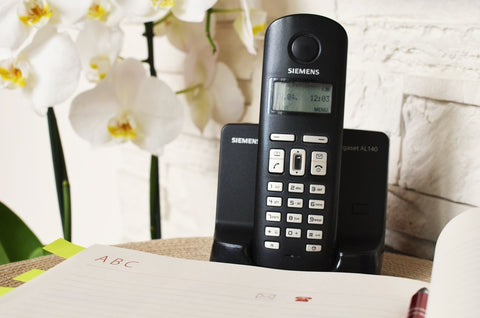Setting up a Home Office

Telecommuters should have an appropriate workspace that allows them to meet their responsibilities to their employer and provide a framework for future roles. Designing a workspace requires some planning and some practical considerations. Some of the essential tasks required to set up a home office include:
- Organizing the workspace.
- Eliminating all safety and fire hazards.
- Creating an environment that supports work.
- Having enough telephone, network, and electrical outlets.
- Keeping work materials safe and secure.
- Shutting out domestic activities.
- Adding temperature, sound, and light controls.

The goals that guide the configuration of the home office include maximizing the separation between the workspace and the rest of the home and making that space functional. A door to the room provides for basic sound control that can help prevent distractions from other household members. In excessively noisy homes, sound absorbing materials on the walls can further improve the work environment.


Setting up an office near a source of natural light will contribute to comfort and productivity, but the area should also have ample supplemental lighting available for work during any time of the day.
Other essential elements of a suitable work area include plenty of storage, file cabinets, and some personal decorations. Investing in an ergonomic chair designed to minimize stress on the body will help the telecommuter stay comfortable and focused during prolonged work periods.
Equipping a Home Office

After satisfying the functional needs of the office, the worker should gather the necessary tools for work. Trying to cut corners might save money, but cost cutting could also result in random performance failures. For example, settling for a cheap, slow data connection might keep the home office connected most of the time, but at critical moments the connection can choke, leaving the telecommuter out of touch with clients and coworkers. The role of a telecommuter demands scalability and connectivity, so a reliable and fast Internet connection should have top priority.


Remote workers should have a laptop or desktop computer that meet the minimum requirements of all the hardware and software systems used in the line of work. Those who sometimes have to commute to the office or work while traveling should use a laptop, so they always have access to their software and data.


The modern workplace also requires a tablet that remote employees can use for teleconferencing, picture taking, checking email and other routine tasks. Tablets work well while attending meetings or having lunch, because of their minimal size and weight. Most workers also need a smartphone to use for backup communications if their Internet connection goes down.
Home based workers might also need a scanner to use for faxing, digital recordkeeping, and creative tasks. The home office should also have a printer that prints high quality documents and reports in either color or black and white.


Many companies have voice over IP (VoIP) phone systems that allow remote workers to have a business telephone on their desk, giving them seamless access to coworkers and voicemail, without having to dial from a mobile or landline phone. Workers without a company provided handset will need to find a quality business phone with access to a voicemail system.
Other essential tools for the home office include:
- VPN access to the corporate network and intranet.
- Teleconferencing gear including software, web cam, and headset.
- Cloud-based software applications and storage to enable productivity either at home or the office.
- Various software. When possible, use the same computer programs your employer uses for email, word processing, spreadsheets, virus protection, image editing, instant messaging and web browsing.
- Regular office supplies. Most home offices need pens, pencils, paper clips, a stapler, document clips, file folders, and binders.
Skills Necessary for Success

Remote workers need to have some basic qualities, to have long-term success. People make the best telecommuters when they can stay happy working alone for prolonged periods. They also must have enough self-motivation to get out of bed and start working on time. Remote workers also need enough self-discipline to stay focused on their work throughout the day and enough resilience to overcome mistakes and poor performances.


Telecommuters must also have the ability to work confidently without supervision and separate work and personal life. The ideal telecommuter must also have time management and organizational skills, productive work habits, and the ability to make independent decisions.
Other qualities of the telecommuter include those that foster success in every work environment:
- Strong communication skills.
- Problem-solving skills.
- Thinking outside the box.
- Utilizing new media.
- Prioritizing information in ways that prevent overload.
- Collaborating, engaging, and leading team efforts.
- Working well with people from other cultures and ethnicities.
- Following procedures.
- Having strong interpersonal skills.
- Knowing when to ask for help.
Telecommuting Mistakes to Avoid

Telecommuters must use vigilance to avoid the traps that can reduce their effectiveness and jeopardize their careers. Some telecommuters become flippant with their jobs and exhibit their attitude by failing to get dressed, not answering the phone during working hours, and letting children and pets invade their workspace. When telecommuter start making these sloppy mistakes, they quickly become unproductive, unmotivated, and unemployed.


For long-term success, remote workers must treat their home-based job as they would treat a regular office job. For example, rather than wear pajamas or underwear to their employer’s office, most people would dress respectably before reporting to work. Telecommuters should do the same thing before reporting to their home office.


Some mistakes result from over-eagerness rather than carelessness and sloppiness. Errors such as taking too much work from too many employers, working too early or too late, losing track of hours worked and accepting too many assignments occur when telecommuters pressure themselves to prove their value and relevance to coworkers and family members. Telecommuters have nothing extraordinary to prove, so they must assert themselves, when necessary, by saying “no” to tasks, assignments, and projects that overload them.
Health and Safety in the Remote Workplace

Telecommuters have responsibilities that extend beyond their job performance: they have the responsibility to maintain a healthy and safe work area. In the office environment, managers have the responsibility for health and safety. In the home office environment, that responsibility falls on the worker. Telecommuters must make sensible decisions to make their home office a safe and healthy place to work. A first aid kit and fire extinguisher should have a visible, accessible place on the wall, to facilitate a fast response to an emergency situation.


Home office exits must always stay free from obstructions, so telecommuters can quickly escape in the event of a fire or other emergency. Keeping the work area free of clutter can minimize the risk of fire and spontaneous combustion.
Extension cords, network cables, and other wires should not cross on the floor in front of doorways or high traffic areas. The homeworker should place all bulky items next to walls and placed on sturdy stands to reduce the risk of property damage or bodily injury.


The home office should have adequate ventilation, and have heating and air conditioning available to maintain safe temperatures. People will always work better and more efficiently in comfortable environments, but excessive heat or cold can cause life-threatening health issues. Ideally, a thermostat independent of the living area of the home should control the temperature in the home office. The home-based worker must also make sure that rugs, trash, and sensitive electronic equipment such as computers never block the flow of air from the heater and air conditioning vents.


While maintaining a safe physical environment in the home office, the telecommuter should also maintain electrical safety. Workers should keep their equipment maintained and in good condition and discarded if power cords become damaged or frayed. The use of surge protectors and uninterruptible power supplies (UPS) can protect sensitive electronic equipment and prevent unnecessary work disruptions. The occupant should periodically check the grounding of all wall outlets and have them repaired by a professional electrician. Also, switches, outlets, receptacles, and junction boxes should all have covers or plates to reduce the risk of electric shock.


After taking steps to create a safe work environment, the homeworker must take measures to reduce physical stress to the body. An ergonomically designed chair, keyboard, and mouse will help decrease the risk of work-related stress injuries. The height of the desk should make it easily accessible while seated without straining the worker’s arms, back or legs.
Some good work practices can also prevent and relieve the physical stress of office work. Eye strain can be minimized by adjusting computer monitor brightness, frequently blinking, and following the 20/20/20 rule: looking away from the computer screen every 20 minutes and gazing at an object 20 feet away for 20 seconds.


To prevent physical stress and other complications, such as blood clots, that result from extended periods of sitting, homeworkers should periodically walk around the office and stretch during periodic breaks away from the desk. While seated, the telecommuter should extend the wrists to help prevent Carpal Tunnel Syndrome and stretch the neck to avoid Tension Neck Syndrome.
Good work habits and health practices include keeping food out of the office. Hand sanitizer and the use antibacterial wipes to clean surfaces will help prevent the buildup of dangerous bacteria in the work area.
Some simple practices can assist the telecommuter to minimize the adverse effects of staying seated at a desk:
- Keep the pelvis opened slightly at 110 to 110-degree angle.
- Bend elbows and rest them comfortably on top of the desk.
- Align upper arms with the torso.
- Feet should rest flat on the floor.
- The head should stay above the hips, looking straight ahead.
- Keep the back of the knees about the width of a fist from the chair seat.
- Straighten wrists while typing or moving the computer mouse.

After mastering the essentials of the home office, telecommuters can start preparing for a successful telecommuting career.
